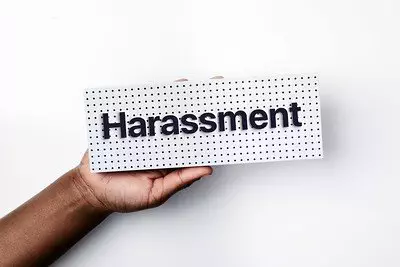
Donate to the Linda McKay-Panos Scholarship Fund

Donate to the Linda McKay-Panos Scholarship Fund
Source: flickr/Alpha Photo
By Temitope Oluleye
Reposted from LawNow 47(2) with permission
Harassment may exist in many forms, including discrimination under human rights laws, a workplace hazard, sexual harassment, and bullying.

By Temitope Oluleye
Harassment may exist in many forms, including discrimination under human rights laws, a workplace hazard, sexual harassment, and bullying.
Harassment is the act of treating another person in a way that causes them to feel insulted, demeaned, sad and sometimes unsafe. It can take many forms including bullying, racial harassment, and sexual harassment.
What can harassment look like? It can mean annoying, intimidating, threatening, or bullying another person. It also includes tormenting a person by persistent attacks or criticism, or subjecting that person to uninvited or unwelcome conduct. Oftentimes, harassment involves a power imbalance, such as between a boss and employee.
Harassment may be verbal, non-verbal, or physical. Examples of verbal harassment include derogatory slurs or jokes. Uninvited or unwanted physical contact is an example of physical harassment. Examples of non-verbal harassment include the display of discriminatory images or leering at another person.
Harassment as Discrimination
In Canada, human rights laws prohibit harassment based on discrimination. The Alberta Human Rights Act prohibits discrimination in five protected areas and on fifteen protected grounds.
The five protected areas are:
1. employment
2. goods, services, accommodation, or facilities customarily available to the public
3. tenancy
4. representations including statements, publications, notices, signs, symbols, and emblems
5. membership in trade unions, employers’ organizations, or occupational associations
The fifteen protected grounds are:
· race
· gender, gender identity and gender expression
· sexual orientation
· religious beliefs
· colour
· physical and mental disability
· age
· ancestry and place of origin
· marital and family status
· source of income
Discrimination is behaviour that results in an adverse effect on the recipient of the discrimination. It could be a distinction, exclusion, restriction, or preference that goes against human rights and fundamental freedoms. Human rights laws prohibit discrimination based on a protected ground and in a protected area.
In the 1990 case of R v Andrews, the Supreme Court of Canada described discrimination as:
… a distinction, whether intentional or not but based on grounds relating to personal characteristics of the individual or group, which has the effect of imposing burdens, obligations, or disadvantages on such individual or group not imposed upon others, or which withholds or limits access to opportunities, benefits, and advantages available to other members of society.
Harassment as a Workplace Hazard
Alberta’s Occupational Health and Safety Act also deals with harassment in the workplace. Section 1(n) of the Act defines harassment:
“harassment” means any single incident or repeated incidents of objectionable or unwelcome conduct, comment, bullying or action by a person that the person knows or ought reasonably to know will or would cause offence or humiliation to a worker, or adversely affect the worker’s health and safety, and includes
(i) conduct, comments, bullying or actions because of race, religious beliefs, colour, physical disability, mental disability, age, ancestry, place of origin, marital status, source of income, family status, gender, gender identity, gender expression and sexual orientation, and
(ii) a sexual solicitation or advance,
but excludes any reasonable conduct of an employer or supervisor related to the normal management of workers or a work site.
The Occupational Health and Safety Act says harassment is workplace violence and a workplace hazard. The Act imposes an obligation on employers to maintain a healthy workplace free from harassment, hostility, and discrimination.
Sexual Harassment
Sexual harassment is discrimination based on gender. It can be upsetting and unsettling.
The Alberta Human Rights Commission describes sexual harassment as:
any unwelcome sexual behaviour that adversely affects, or threatens to affect, directly or indirectly, a person’s job security, working conditions or prospects for promotion or earnings; or prevents a person from getting a job, living accommodations or any kind of public service.
The Supreme Court of Canada (in the 1989 case of Janzen v Platy Enterprises Ltd.) defines sexual harassment in the workplace as “unwelcome conduct of a sexual nature that detrimentally affects the work environment or leads to adverse job‑related consequences for the victims of the harassment”.
Bullying
Bullying is aggression and a form of harassment. Bullying may be a willful, deliberate act of hostility which induces fear in the victim through the threat of further aggression. Bullying can take different forms – emotional, psychological, physical, verbal, online, or cyber. Bullying that takes the form of emotional or psychological aggression may be subtle, and though it is not visible, it can still be very painful to its victims.
Criminal Behaviour
Sometimes, harassment can be criminal in nature, such as when physical or sexual assault occurs. Criminal harassment is an offense which carries penalties under Canada’s Criminal Code.
Intention versus Impact
The harasser’s intention does not matter. Instead, the law looks at the impact of the harassing or discriminatory action. The courts have said discrimination does not have to be intentional for it to be illegal.
Alberta Civil Liberties Research Centre
Alberta Civil Liberties Research Centre (ACLRC) provides information to the public as well as research on contemporary civil liberties and human rights issues that are of concern to Albertans.
Find more information (including videos) about harassment and bullying and making a complaint at the Commission on ACLRC’s website: www.aclrc.com.




2500 University Drive NW
Calgary, AB T2N 1N4
(403) 220-2505
aclrc@ucalgary.ca